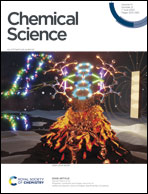Radical ring-opening polymerization of sustainably-derived thionoisochromanone†
Abstract
We present the synthesis, characterization and radical ring-opening polymerization (rROP) capabilities of thionoisochromanone (TIC), a fungi-derivable thionolactone. TIC is the first reported six-membered thionolactone to readily homopolymerize under free radical conditions without the presence of a dormant comonomer or repeated initiation. Even more, the resulting polymer is fully degradable under mild, basic conditions. Computations providing molecular-level insights into the mechanistic and energetic details of polymerization identified a unique S,S,O-orthoester intermediate that leads to a sustained chain-end. This sustained chain-end allowed for the synthesis of a block copolymer of TIC and styrene under entirely free radical conditions without explicit radical control methods such as reversible addition–fragmentation chain transfer polymerization (RAFT). We also report the statistical copolymerization of ring-retained TIC and styrene, confirmed by elemental analysis and energy-dispersive X-ray spectroscopy (EDX). Computations into the energetic details of copolymerization indicate kinetic drivers for ring-retaining behavior. This work provides the first example of a sustainable feedstock for rROP and provides the field with the first six-membered monomer susceptible to rROP, expanding the monomer scope to aid our fundamental understanding of thionolactone rROP behavior.



 Please wait while we load your content...
Please wait while we load your content...